2.6. 5: Succession
ECOLOGICAL SUCCESSION
After the retreat of glaciers following the last ice age, new virgin land was exposed with nothing living on it. It didn’t remain that way for long. Soon the land was covered with mosses and lichen. Gradually organic material was added to the simple mineral soils left behind by the glaciers and from the erosion of bare rock. This created conditions that allowed, first grasses and small herbs to establish, and eventually over time for northern Europe to be covered by woodland.
This directional change in community is termed succession.
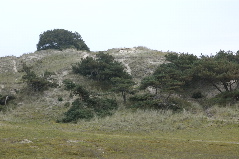 PRIMARY SUCCESSION
PRIMARY SUCCESSION
Involves the colonization of newly created land by organisms.
o River deltas
o Volcanic larva fields
o Sand dunes
o Glacial deposits
Simple mineral soils evolved from erosion are, slowly invaded by mosses and lichen. These and other early plants are adapted to survive periods of drought as water drains quickly away from the mineral soils. These contribute organic matter to the soil as they die and spread, this creates conditions that allow larger mosses to invade. These help add more organic matter to the soil, which improves its water holding capacity, and provide a habitat for soil organisms that help speed up the breakdown of organic matter and release of nutrients.
Conditions then become favorable for ferns and higher plants to establish on the primitive soils and humus forms as more organic matter is added. Eventually shrubs and trees invade, first from wind-dispersed seeds and eventfully by animal dispersal. Eventually over time a stable woodland community develops.
Succession progress in stages from;
Pioneer species that are adapted to develop in limiting environments to a stable developed community. This final community is termed a CLIMAX COMMUNITY .
As the community develops, so biodiversity also increases.
The entire process from bare rock to climax is called a SERE and that progress directionally through SERAL STAGES.
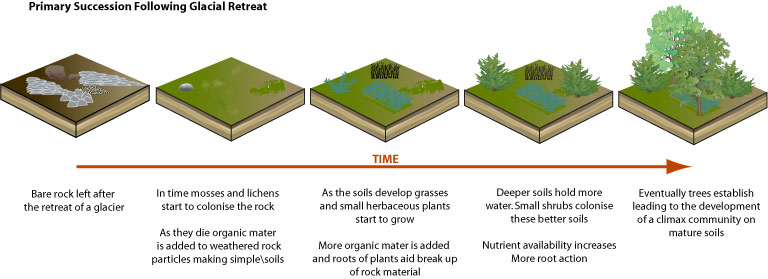
<br
An example of primary succession can be seen in the development of the natural broad-leafed forest that covered much of Northern Europe following the end of the last Ice Age.
We know that following the retreat of ice around 10,000 years until around 7,500 years ago, a Boreal community formed. First of Juniper then birch and later pine. As the climate warmed so the community changed from a dominance of birch to Oak with abundant wych elm, alder and lime, marking a change to warm, moist Atlantic period until about 5,000 years ago. Much of Northern Europe would still be covered in this mixed broad leaf forest if Neolithic man had not started changes the plant community around him as agriculture developed.
|
Ecological period
|
Years ago
|
Community
|
|---|---|---|
|
Pre-Boreal
|
10,000 - 9,500
|
Tundra with patches of willow, birch and pine
|
|
Boreal
|
9,500 - 7,500
|
Hazel, Pine
|
|
Atlantic
|
7,500 - 5,000
|
Hazel, Oak, Elm Lime , Ash, Alder |
|
Sub-Boreal
|
5,000 - 2,500
|
Mixed Oak with many cleared areas either being farmed or abandoned and returned to woodland
|
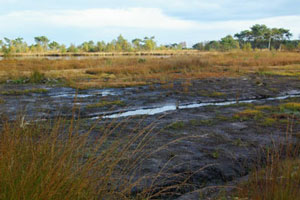 If primary succession starts on dry land it is a XEROSERE
If primary succession starts on dry land it is a XEROSERE
If it starts in water (a pond) it is a HYDROSERE.
Pond and lakes get continuous inputs of sediment from streams and rivers that open into them. Some of this sediment passes through but a lot sinks to the pond bottom. As plant communities develop they add dead organic material to these sediments.
Over time these sediments build up allowing rooted plants to invade the pond margins as the pond slowly fills in. This eventually leads to the establishment of climax communities around the pond margins and in smaller ponds the eventual disappearance of the pond. In regions where rainfall is high, the xerosere climax community mat not establish after a hydrosere. The wet conditions creat the development of raised bogs as the climax following hydrosere succession.
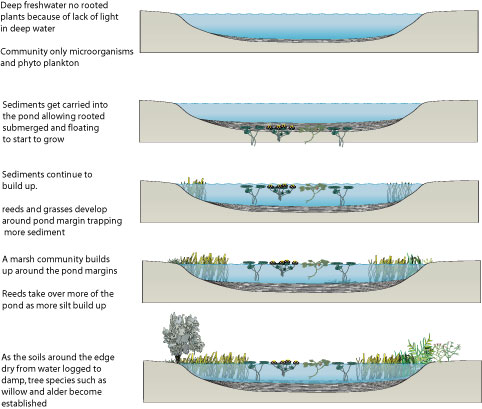
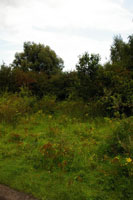 SECONDARY SUCCESSION
SECONDARY SUCCESSION
Where an already established community is suddenly destroyed, such as following fire or flood or even human activity (ploughing) an abridged version of succession occurs.
This secondary succession occurs on soils that are already developed and ready to accept seeds carried in by the wind. Also there are often dormant seeds left in the soil from the previous community. This shortens the number of seral stages the community goes through .
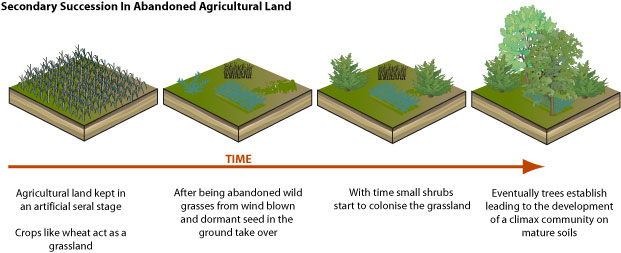
Good examples of secondary succession have been studied in abandoned form land in North Carolina in the United States. The farmland had become infertile through not enough nutrients being returned after crops had been taken and through wind erosion. As the land became unproductive and uneconomical to farm, farmers simply abandoned the land. This left patches of former farmland of various ages.
|
Years after abandonment
|
Dominant species
|
Predominant Forest Vegetation
|
|---|---|---|
|
0
|
Crabgrass
|
Developing grassland community
|
|
1
|
Crabgrass, Horseweeds, Pigweed
|
Community starts to be dominated by Horseweed
|
|
2
|
Aster, Crabgrass, Ragweed
|
Grass scrub is developing |
|
3-18
|
Broomsedge, Pine later
|
Developed grass scrub community with later invading pine
|
|
18-30
|
Pine
|
Immature pine forest
|
|
30-70
|
Pine, Young Hickories and Oaks later
|
Mature pine wood with understorey of young hardwoods later
|
|
70-100
|
Pine, Hickories, Oaks
|
Transitonal stage between Pine and Hardwood forest
|
|
100+
|
Oak, Hickory
|
Mature mixed hardwood forest
|
 Click on Icon to open lecture slides as an adobe reader file
Click on Icon to open lecture slides as an adobe reader file